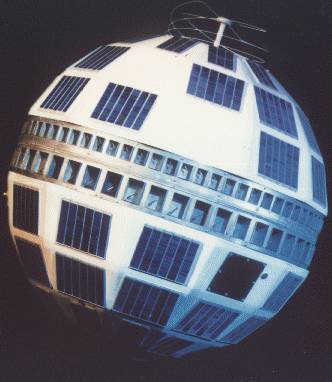Monday, July 09, 2012
Happy 50th, Telstar 1!
The above image shows Telstar 1. Image Credit: NASA
Tuesday, July 10th, marks the 50th anniversary (July 10, 1962) of the launch of communication satellite Telstar 1 aboard a Thor-Delta rocket. Telstar 1 successfully relayed the first television pictures, telephone calls, fax images, and provided the first trans-Atlantic television feed. Telstar 1 was soon follower by a sister satellite, Telstar 2, launched May 7, 1963.
Belonging to American Telephone & Telegraph (AT&T), Telstar 1 was part of a multi-national agreement between AT&T, Bell Telephone Laboratories, NASA, the British General Post Office, and the French National PTT (Post, Telegraph & Telecom Office) to develop experimental satellite communications over the Atlantic Ocean. The US ground station was Andover Earth Station in Andover, Maine, built by Bell Labs.
The satellite was built by a team at Bell Telephone Laboratories. Telstar 1 is roughly spherical, measures 34.5 inches (876.30 mm) in length, and weighs about 170 pounds (77 kg). Its dimensions were limited by what would fit on one of NASA's Delta rockets. Telstar was spin-stabilized, and its outer surface was covered with solar cells to generate electrical power. The power produced was a tiny 14 watts.
The original Telstar had one innovative transponder to relay data, which was a television channel or multiplexed telephone circuits. An omnidirectional array of small antenna elements around the satellite's "equator" received 6 GHz microwave signals to be relayed. The transponder converted the frequency to 4 GHz, amplified the signals in a traveling-wave tube, and retransmitted them omnidirectionally via the adjacent array of larger box-shaped cavities. The prominent helical antenna was for telecommands from a ground station.
Telstar 1 was the first privately-sponsored space launch. A medium-altitude satellite, it was placed in an elliptical orbit completed once every 2 hours and 37 minutes, inclined at an angle of approximately 45 degrees to the equator, with perigee about 952 km from Earth and apogee about 5933 km from Earth. This is in contrast to most of today's communications satellites, which are placed in circular geostationary orbits.
Because of its non-geosynchronous orbit, Telstar's availability for transatlantic signals was limited to the 20 minutes in each 2.5 hour orbit when the satellite passed over the Atlantic Ocean. Ground antennas had to track the satellite with a pointing error of less than 0.06 degrees as it moved across the sky at up to 1.5 degrees per second.
Since the transmitting and receiving radio systems on board Telstar were not nearly as powerful or capable as those of today's satellites, the ground antennas had to be huge. Morimi Iwama and Jan Norton of Bell Laboratories were in charge of designing and building the electrical portions of the system that steered the antennas. The aperture of the antennas was 3,600 square feet (330 m2). The antennas were 177 feet (54 m) long and weighed 380 tons. The antennas were housed in radomes the size of a 14-story office building.
While Telstar 1 ushered in a new age of the benevolent use of technology, it became a victim of technology during the Cold War. The day before Telstar 1 was launched, the United States had tested a high-altitude nuclear bomb (called Starfish Prime) which energized the Earth's Van Allen Belt where Telstar 1 went into orbit. This vast increase in radiation, combined with subsequent high-altitude blasts, including a Soviet test in October, overwhelmed Telstar's fragile transistors. Telstar 1 went out of service in early December 1962, but was restarted by a workaround in early January 1963. After encountering more issues, Telstar 1 went out of service for the last time, on February 21, 1963. As of this writing, Telstar 1 and 2 remain in Earth orbit.
To catch postings for all my blogs, subscribe on Twitter to twitter.com/RoamingAstro . Like what you see? Let me know! Email: RoamingAstroInput@gmail.com .
-
Subscribe to:
Post Comments (Atom)

No comments:
Post a Comment